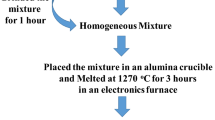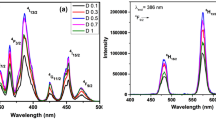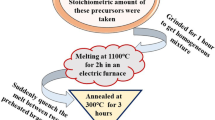Abstract
In this present work, Dysprosium (Dy3+) ions doped potassium zinc strontium borate (KZSB) glasses were synthesized via the melt-quench method. X-ray diffraction (XRD) study of the prepared glasses shows a broad hump and confirms the amorphous nature of the glasses. Various vibrational shoulders were seen in the Fourier transform infrared (FT-IR) spectrum. Thermo gravimetric analysis–differential scanning calorimetry (TGA–DSC) was carried out to check the thermal stability and corresponding weight loss behavior of the un-doped sample. Absorption spectra were recorded for un-doped as well as doped glasses in the UV–VIS–NIR region, and the corresponding optical band gap was calculated. The photoluminescence (PL) spectra of as-prepared Dy3+ doped KZSB glasses under 350 nm excitation show three peaks at 482, 575 and 665 nm corresponding to the transitions 4F9/2 → 6H15/2, 6H13/2 and 6H11/2. Commission Internationale de I'Eclairage (CIE) chromaticity coordinates calculated from the emission data lie in the white region. The photometric analysis of prepared glasses under UV lamp with 365 nm excitation also shows white emission. Temperature-dependent PL (TDPL) investigation demonstrates the superiority in thermal stability of the as-prepared glasses, with an activation energy of 0.232 eV estimated for 0.5 mol% (optimized concentration of rare earth ion) of Dy3+ ions. After analyzing the results of all studies, we propose to use these borate glasses doped with Dy3+ ions for white light-emitting diodes (w-LEDs) fabrication and other solid state lighting (SSL) applications.















Similar content being viewed by others
Data availability
The data that support the findings of this study are available on request from the corresponding author Prof. A.S. Rao. The data are not publicly available due to restrictions, e.g. their containing information that could compromise the privacy of research participants.
References
R. Bajaj, A.S. Rao, G.V. Prakash, Photoluminescence down-shifting studies of thermally stable Eu3+ ions doped borosilicate glasses for visible red photonic device applications. J. Non Cryst. Solids 575, 121184 (2022). https://doi.org/10.1016/j.jnoncrysol.2021.121184
P. Rekha Rani, M. Venkateswarlu, S. Mahamuda, K. Swapna, N. Deopa, A.S. Rao, Spectroscopic studies of Dy3+ ions doped barium lead alumino fluoro borate glasses. J. Alloys Compd. 787, 503–518 (2019). https://doi.org/10.1016/j.jallcom.2019.02.088
J. Xi, G. Chen, F. Liu, F. Shang, J. Xu, C. Zhou, C. Yuan, Synthesis, microstructure and characterization of ultra-low permittivity CuO–ZnO–B2O–Li2O glass/Al2O3 composites for ULTCC application. Ceram. Int. 45, 24431–24436 (2019). https://doi.org/10.1016/j.ceramint.2019.08.166
S. Kaur, A.K. Vishwakarma, N. Deopa, A. Prasad, M. Jayasimhadri, A.S. Rao, Spectroscopic studies of Dy3+ doped borate glasses for cool white light generation. Mater. Res. Bull. 104, 77–82 (2018). https://doi.org/10.1016/j.materresbull.2018.04.002
Y. Gao, J. Qiu, D. Zhou, Investigation of optical properties: Eu with Al codoping in aluminum silicate glasses and glass-ceramics. J. Am. Ceram. Soc. 100, 2901–2913 (2017). https://doi.org/10.1111/jace.14807
H. Wang, J. Liu, J. Zhai, B. Shen, Z. Pan, K. Yang, J. Liu, Effect of K2O content on breakdown strength and energy-storage density in K2O–BaO–Nb2O5–SiO2 glass-ceramics. Ceram. Int. 43, 4183–4187 (2017). https://doi.org/10.1016/j.ceramint.2016.12.042
M. Monisha, N. Mazumder, G. Lakshminarayana, S. Mandal, S.D. Kamath, Energy transfer and luminescence study of Dy3+ doped zinc-aluminoborosilicate glasses for white light emission. Ceram. Int. 47, 598–610 (2021). https://doi.org/10.1016/j.ceramint.2020.08.167
D. Ramachari, L. Rama Moorthy, C.K. Jayasankar, Spectral investigations of Sm3+-doped oxyfluorosilicate glasses. Mater. Res. Bull. 48, 3607–3613 (2013). https://doi.org/10.1016/j.materresbull.2013.05.081
S.-F. Wang, Y.-F. Hsu, H.-C. Lu, S.-C. Lo, C.-S. Cheng, B2O3-free SiO2–Al2O3–SrO–La2O3–ZnO–TiO2 glass sealants for intermediate temperature solid oxide fuel cell applications. Int. J. Hydrog. Energy 37, 5901–5913 (2012). https://doi.org/10.1016/j.ijhydene.2011.12.121
H. Gui, C. Li, C. Lin, Q. Zhang, Z. Luo, L. Han, J. Liu, T. Liu, A. Lu, Glass forming, crystallization, and physical properties of MgO–Al2O3–SiO2–B2O3 glass-ceramics modified by ZnO replacing MgO. J. Eur. Ceram. Soc. 39, 1397–1410 (2019). https://doi.org/10.1016/j.jeurceramsoc.2018.10.002
Y. Gao, Y. Hu, P. Ren, D. Zhou, J. Qiu, Effect of Li+ ions on the enhancement upconversion and stokes emission of NaYF4:Tb, Yb co-doped in glass-ceramics. J. Alloys Compd. 667, 297–301 (2016). https://doi.org/10.1016/j.jallcom.2016.01.200
A. Mills, High-brightness LEDs lighting up the future. III-Vs Rev. 14(1), 32–37 (2001). https://doi.org/10.1016/S0961-1290(01)89005-0
Z. Lei, G. Xia, L. Ting, G. Xiaoling, L.Q. Ming, S. Guangdi, Color rendering and luminous efficacy of trichromatic and tetrachromatic LED-based white LEDs. Microelectron. J. 38, 1–6 (2007). https://doi.org/10.1016/j.mejo.2006.09.004
L.I. Panlai, W. Zhijun, Y. Zhiping, G.U.O. Qinglin, A potential single-phased white-emitting LiBaBO3:Ce3+, Eu2+ phosphor for white LEDs. J. Rare Earths 28, 523–525 (2010). https://doi.org/10.1016/S1002-0721(09)60145-9
C. Zhu, Y. Yang, X. Liang, S. Yuan, G. Chen, Rare earth ions doped full-color luminescence glasses for white LED. J. Lumin. 126, 707–710 (2007). https://doi.org/10.1016/j.jlumin.2006.10.028
A. Aboalatta, J. Asad, M. Humaid, H. Musleh, S.K.K. Shaat, K. Ramadan, M.I. Sayyed, Y. Alajerami, N. Aldahoudi, Experimental investigation of zinc sodium borate glass systems containing barium oxide for gamma radiation shielding applications. Nucl. Eng. Technol. 53, 3058–3067 (2021). https://doi.org/10.1016/j.net.2021.04.002
Y. Gao, Y. Hu, D. Zhou, J. Qiu, Effect of crystalline fraction on upconversion luminescence in Er3+/Yb3+ Co-doped NaYF4 oxyfluoride glass-ceramics. J. Eur. Ceram. Soc. 37, 763–770 (2017). https://doi.org/10.1016/j.jeurceramsoc.2016.09.036
A. Kumar, Anu, M.K. Sahu, Ravita, S. Dahiya, N. Deopa, A. Kumar, R. Punia, A.S. Rao, Spectral characteristics of Tb3+ doped ZnF2–K2O–Al2O3–B2O3 glasses for epoxy free tricolor w-LEDs and visible green laser applications. J. Lumin. 244, 118676 (2021). https://doi.org/10.1016/j.jlumin.2021.118676
Y. Gao, S. Murai, K. Shinozaki, J. Qiu, K. Tanaka, Phase-selective distribution of Eu2+and Eu3+ in oxide and fluoride crystals in glass-ceramics for warm white-light-emitting diodes. ACS Appl. Electron. Mater. 1, 961–971 (2019). https://doi.org/10.1021/acsaelm.9b00129
Y. Gao, Y. Hu, P. Ren, D. Zhou, J. Qiu, Phase transformation and enhancement of luminescence in the Tb3+-Yb3+ co-doped oxyfluoride glass ceramics containing NaYF4 nanocrystals. J. Eur. Ceram. Soc. 36, 2825–2830 (2016). https://doi.org/10.1016/j.jeurceramsoc.2016.04.027
S.A. Azizan, S. Hashim, N.A. Razak, M.H.A. Mhareb, Y.S.M. Alajerami, N. Tamchek, Physical and optical properties of Dy3+: Li2O–K2O–B2O3 glasses. J. Mol. Struct. 1076, 20–25 (2014). https://doi.org/10.1016/j.molstruc.2014.07.032
G.N. Carneiro, H. Vargas, J.A. Sampaio, Thermo-optical and structural properties of barium aluminoborate glasses. J. Alloys Compd. 777, 1327–1333 (2019). https://doi.org/10.1016/j.jallcom.2018.11.044
Y. Gao, S. Murai, K. Fujita, K. Tanaka, Visible and near-infrared photoluminescence enhanced by Ag nanoparticles in Sm3+-doped aluminoborate glass. Opt. Mater. (Amst) 86, 611–616 (2018). https://doi.org/10.1016/j.optmat.2018.10.018
S. Mahamuda, K. Swapna, M. Venkateswarlu, A. Srinivasa Rao, S. Shakya, G. Vijaya Prakash, Spectral characterisation of Sm3+ ions doped Oxy-fluoroborate glasses for visible orange luminescent applications. J. Lumin. 154, 410–424 (2014). https://doi.org/10.1016/j.jlumin.2014.05.017
T.Y. Lim, H. Wagiran, R. Hussin, S. Hashim, M.A. Saeed, Physical and optical properties of dysprosium ion doped strontium borate glasses. Phys. B Condens. Matter 451, 63–67 (2014). https://doi.org/10.1016/j.physb.2014.06.028
A. Ichoja, S. Hashim, S.K. Ghoshal, Judd-Ofelt calculations for spectroscopic characteristics of Dy3+-activated strontium magnesium borate glass. Optik (Stuttg) 218, 165001 (2020). https://doi.org/10.1016/j.ijleo.2020.165001
P.P. Pawar, S.R. Munishwar, R.S. Gedam, Physical and optical properties of Dy3+/Pr3+ Co-doped lithium borate glasses for W-LED. J. Alloys Compd. 660, 347–355 (2016). https://doi.org/10.1016/j.jallcom.2015.11.087
M.A. Algradee, A.E.B. Alwany, M. Sultan, M. Elgoshimy, Q. Almoraisy, Physical and optical properties for Nd2O3 doped lithium-zinc-phosphate glasses. Optik (Stuttg) 142, 13–22 (2017). https://doi.org/10.1016/j.ijleo.2017.05.065
H. George, N. Deopa, S. Kaur, A. Prasad, M. Sreenivasulu, M. Jayasimhadri, A.S. Rao, Judd-Ofelt parametrization and radiative analysis of Dy3+ ions doped Sodium Bismuth Strontium Phosphate glasses. J. Lumin. 215, 116693 (2019). https://doi.org/10.1016/j.jlumin.2019.116693
X. Peng, Y. Pu, X. Du, J. Ji, S. Zhou, L. Zhang, The effect of glass network structure on interfacial polarization in Na2O–K2O–Nb2O5–SiO2–BaO glass-ceramics. J. Alloys Compd. 845, 155645 (2020). https://doi.org/10.1016/j.jallcom.2020.155645
K. Swapna, S. Mahamuda, A.S. Rao, T. Sasikala, P. Packiyaraj, L.R. Moorthy, G.V. Prakash, Luminescence characterization of Eu3+ doped Zinc Alumino Bismuth Borate glasses for visible red emission applications. J. Lumin. 156, 80–86 (2014). https://doi.org/10.1016/j.jlumin.2014.07.022
S. Mahamuda, K. Swapna, P. Packiyaraj, A. Srinivasa Rao, G. Vijaya Prakash, Lasing potentialities and white light generation capabilities of Dy3+ doped oxy-fluoroborate glasses. J. Lumin. 153, 382–392 (2014). https://doi.org/10.1016/j.jlumin.2014.03.009
O.B. Aljewaw, M.K.A. Karim, H.M. Kamari, M.H.M. Zaid, A.A. Salim, M.H.A. Mhareb, Physical and spectroscopic characteristics of lithium-aluminium-borate glass: Effects of varying Nd2O3 doping contents. J. Non Cryst. Solids 575, 121214 (2022). https://doi.org/10.1016/j.jnoncrysol.2021.121214
P.R. Rani, M. Venkateswarlu, S. Mahamuda, K. Swapna, N. Deopa, A.S. Rao, G.V. Prakash, Structural, absorption and photoluminescence studies of Sm3+ ions doped barium lead alumino fluoro borate glasses for optoelectronic device applications. Mater. Res. Bull. 110, 159–168 (2019). https://doi.org/10.1016/j.materresbull.2018.10.033
V. Venkatramu, P. Babu, C.K. Jayasankar, T. Tröster, W. Sievers, G. Wortmann, Optical spectroscopy of Sm3+ ions in phosphate and fluorophosphate glasses. Opt. Mater. (Amst) 29, 1429–1439 (2007). https://doi.org/10.1016/j.optmat.2006.06.011
S. Damodaraiah, V. Reddy Prasad, S. Babu, Y.C. Ratnakaram, Structural and luminescence properties of Dy3+ doped bismuth phosphate glasses for greenish yellow light applications. Opt. Mater. (Amst) 67, 14–24 (2017). https://doi.org/10.1016/j.optmat.2017.03.023
C.R. Kesavulu, H.J. Kim, S.W. Lee, J. Kaewkhao, N. Chanthima, Y. Tariwong, Physical, vibrational, optical and luminescence investigations of Dy3+-doped yttrium calcium silicoborate glasses for cool white LED applications. J. Alloys Compd. 726, 1062–1071 (2017). https://doi.org/10.1016/j.jallcom.2017.08.091
K. Swapna, S. Mahamuda, A. Srinivasa Rao, S. Shakya, T. Sasikala, D. Haranath, G. Vijaya Prakash, Optical studies of Sm3+ ions doped Zinc Alumino Bismuth Borate glasses. Spectrochim Acta Part A Mol. Biomol. Spectrosc. 125, 53–60 (2014). https://doi.org/10.1016/j.saa.2014.01.025
T. Som, B. Karmakar, Nephelauxetic effect of low phonon antimony oxide glass in absorption and photoluminescence of rare-earth ions. Spectrochim Acta Part A Mol. Biomol. Spectrosc. 79, 1766–1782 (2011). https://doi.org/10.1016/j.saa.2011.05.054
T. Suhasini, B.C. Jamalaiah, T. Chengaiah, J. Suresh Kumar, L. Rama Moorthy, An investigation on visible luminescence of Ho3+ activated LBTAF glasses. Phys. B Condens. Matter 407, 523–527 (2012). https://doi.org/10.1016/j.physb.2011.11.029
N. Deopa, A.S. Rao, S. Mahamuda, M. Gupta, M. Jayasimhadri, D. Haranath, G.V. Prakash, Spectroscopic studies of Pr3+ doped lithium lead alumino borate glasses for visible reddish orange luminescent device applications. J. Alloys Compd. 708, 911–921 (2017). https://doi.org/10.1016/j.jallcom.2017.03.020
Anu, N. Deopa, A.S. Rao, Structural and luminescence characteristics of thermally stable Dy3+ doped oxyfluoride strontium zinc borosilicate glasses for photonic device applications. Opt. Laser Technol. 154, 108328 (2022). https://doi.org/10.1016/j.optlastec.2022.108328
S.S. Danewalia, K. Singh, S.K. Arya, Influence of vanadium oxide on non-isothermal crystallization kinetics of zinc lithium borate glasses. J. Non Cryst. Solids 553, 120471 (2021). https://doi.org/10.1016/j.jnoncrysol.2020.120471
W.T. Carnall, P.R. Fields, K. Rajnak, Electronic energy levels of the trivalent lanthanide aquo ions. IV. Eu3+. J. Chem. Phys. 49, 4424–4442 (1968). https://doi.org/10.1063/1.1669893
P. Taylor, J.C. Barthelat, P. Durand, A. Serafini, Non-empirical pseudopotentials for molecular calculations. Mol. Phys. 33, 159–180 (1977)
S. Kaur, M. Jayasimhadri, A.S. Rao, A novel red emitting Eu3+ doped calcium aluminozincate phosphor for applications in w-LEDs. J. Alloys Compd. 697, 367–373 (2017). https://doi.org/10.1016/j.jallcom.2016.12.150
M.K. Sahu, J. Mula, White light emitting thermally stable bismuth phosphate phosphor Ca3Bi(PO4)3:Dy3+ for solid-state lighting applications. J. Am. Ceram. Soc. 102, 6087–6099 (2019). https://doi.org/10.1111/jace.16479
S. Selvi, G. Venkataiah, S. Arunkumar, G. Muralidharan, K. Marimuthu, Structural and luminescence studies on Dy3+ doped lead boro-telluro-phosphate glasses. Phys. B Condens. Matter 454, 72–81 (2014). https://doi.org/10.1016/j.physb.2014.07.018
Q. Meng, B. Chen, W. Xu, Y. Yang, X. Zhao, W. Di, S. Lu, X. Wang, J. Sun, L. Cheng, T. Yu, Y. Peng, Size-dependent excitation spectra and energy transfer in Tb3+-doped Y2O3 nanocrystalline. J. Appl. Phys. 102, 1–7 (2007). https://doi.org/10.1063/1.2803502
P. Du, X. Huang, J.S. Yu, Facile synthesis of bifunctional Eu3+-activated NaBiF4 red-emitting nanoparticles for simultaneous white light-emitting diodes and field emission displays. Chem. Eng. J. 337, 91–100 (2018). https://doi.org/10.1016/j.cej.2017.12.063
S. Kaur, A.S. Rao, M. Jayasimhadri, Spectroscopic and photoluminescence characteristics of Sm3+ doped calcium aluminozincate phosphor for applications in w-LED. Ceram. Int. 43, 7401–7407 (2017). https://doi.org/10.1016/j.ceramint.2017.02.129
I. Kumar, A.K. Gathania, Photoluminescence and quenching study of the Sm3+-doped LiBaPO4 phosphor. J. Mater. Sci. Mater. Electron. 33, 328–341 (2022). https://doi.org/10.1007/s10854-021-07301-7
T. Srihari, C.K. Jayasankar, Fluorescence properties and white light generation from Dy3+-doped niobium phosphate glasses. Opt. Mater. (Amst) 69, 87–95 (2017). https://doi.org/10.1016/j.optmat.2017.04.001
R. Bajaj, A.S. Rao, G.V. Prakash, Linear and nonlinear photoluminescence from thermally stable KYF4:Eu3+ cubic nanocrystals. J. Alloys Compd. 885, 160893 (2021). https://doi.org/10.1016/j.jallcom.2021.160893
Poonam, Shivani, Anu, A. Kumar, M.K. Sahu, P.R. Rani, N. Deopa, R. Punia, A.S. Rao, Judd-Ofelt parameterization and luminescence characterization of Dy3+ doped oxyfluoride lithium zinc borosilicate glasses for lasers and w-LEDs. J. Non Cryst. Solids. 544, 120187 (2020). https://doi.org/10.1016/j.jnoncrysol.2020.120187
C.S. McCamy, Correlated color temperature as an explicit function of chromaticity coordinates. Color Res. Appl. 17, 142–144 (1992). https://doi.org/10.1002/col.5080170211
N. Deopa, S. Saini, S. Kaur, A. Prasad, A.S. Rao, Spectroscopic investigations on Dy3+ ions doped zinc lead alumino borate glasses for photonic device applications. J. Rare Earths 37, 52–59 (2019). https://doi.org/10.1016/j.jre.2018.04.013
P. Babu, K.H. Jang, C.S. Rao, L. Shi, C.K. Jayasankar, V. Lavín, H.J. Seo, White light generation in Dy3+-doped oxyfluoride glass and transparent glass-ceramics containing CaF2 nanocrystals. Opt. Express 19, 1836–1841 (2011)
S. Kaur, D. Arora, S. Kumar, G. Singh, S. Mohan, P. Kaur, Kriti, P. Kaur, D.P. Singh, Blue-yellow emission adjustability with aluminium incorporation for cool to warm white light generation in dysprosium doped borate glasses. J. Lumin. 202, 168–175 (2018). https://doi.org/10.1016/j.jlumin.2018.05.034
Ravita, A.S. Rao, Effective energy transfer from Dy3+ to Tb3+ ions in thermally stable KZABS glasses for intense green emitting device applications. J. Lumin. 239, 118325 (2021). https://doi.org/10.1016/j.jlumin.2021.118325
E.A. Rathnakumari, S.M.M. Kennedy, Synthesis and photoluminescence characteristics of the near white emitting Dy3+ ions activated NaMBi2−x(PO4)3 [M: Ba/Ca/Ca0.5+Sr0.5/Sr/Sr0.5 + Ba0.5] phosphors. Optik (Stuttg) 275, 170601 (2023). https://doi.org/10.1016/j.ijleo.2023.170601
A. Vidhi, A. Ankita, A. Anu, A.S. Rao, Spectroscopic characterizations of Dy3+ ions doped phosphate glasses for epoxy-free white LED applications. Opt. Mater. (Amst) 132, 112863 (2022). https://doi.org/10.1016/j.optmat.2022.112863
M.K. Sahu, H. Kaur, B.V. Ratnam, J.S. Kumar, M. Jayasimhadri, Structural and spectroscopic characteristics of thermally stable Eu3+ activated barium zinc orthophosphate phosphor for white LEDs. Ceram. Int. 46, 26410–26415 (2020). https://doi.org/10.1016/j.ceramint.2020.07.263
M.K. Sahu, M. Jayasimhadri, Conversion of blue emitting thermally stable Ca3Bi(PO4)3 host as a color tunable phosphor via energy transfer for luminescent devices. J. Lumin. 227, 117570 (2020). https://doi.org/10.1016/j.jlumin.2020.117570
Acknowledgements
One of the authors Ms. Sheetal Kumari would like to thank the University Grants Commission (UGC), Government of India for providing her with Junior Research Fellowship (JRF) to carry out her research work at Delhi Technological University [1431/(CSIR-UGC NET JUNE 2019)].
Funding
Ms. Sheetal Kumari was supported by a Junior Research Fellowship (JRF) awarded by CSIR-UGC, Government of India [1431/(CSIR-UGC NET JUNE 2019)].
Author information
Authors and Affiliations
Contributions
SK: work plan, experimental work, manuscript writing. Anu: experimental help, data analysis. AP: data analysis, validation of results, manuscript writing. PR: experimental help, calculations. ASR: work plan, validation of results, manuscript corrections.
Corresponding author
Ethics declarations
Conflict of interest
The authors declare that they have no known competing financial interests or personal relationships that could have appeared to influence the work reported in this paper.
Additional information
Publisher's Note
Springer Nature remains neutral with regard to jurisdictional claims in published maps and institutional affiliations.
Rights and permissions
Springer Nature or its licensor (e.g. a society or other partner) holds exclusive rights to this article under a publishing agreement with the author(s) or other rightsholder(s); author self-archiving of the accepted manuscript version of this article is solely governed by the terms of such publishing agreement and applicable law.
About this article
Cite this article
Kumari, S., Anu, Prasad, A. et al. Prospective applications of thermally stable Dy3+ doped potassium zinc strontium borate (KZSB) glasses in w-LEDs. J Mater Sci: Mater Electron 34, 907 (2023). https://doi.org/10.1007/s10854-023-10272-6
Received:
Accepted:
Published:
DOI: https://doi.org/10.1007/s10854-023-10272-6




